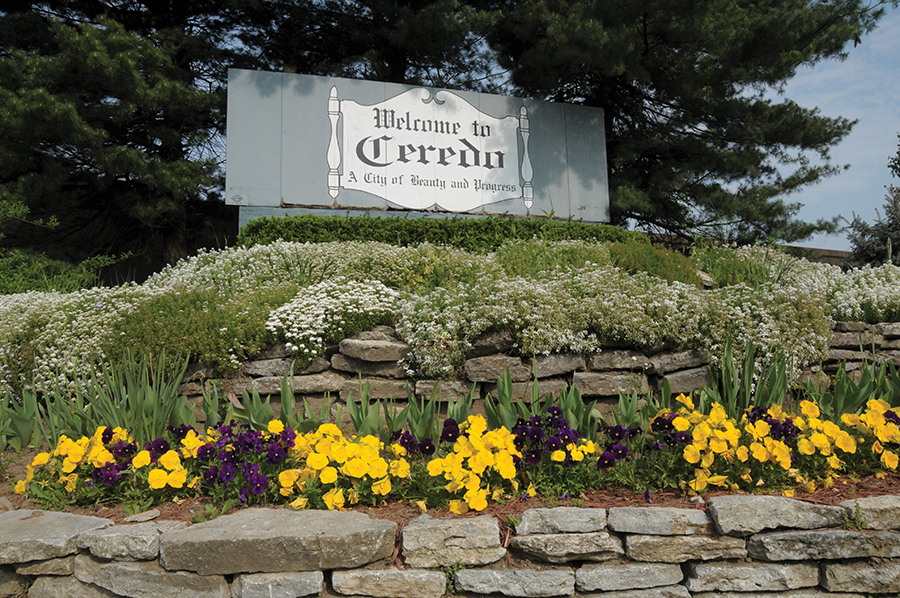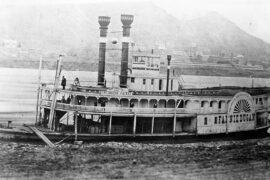Ceredo and Kenova – the two westernmost towns in West Virginia – stand side by side. Driving through them on U.S. 60, you have to keep a sharp eye out if you’re going to detect when you leave one and enter the other. But Ceredo and Kenova each have their own history, their own heritage and their own story to tell…
By James E. Casto
HQ 65 | SUMMER 2008
Ceredo
Former Wayne County School Superintendent Mose Napier has been Mayor of Ceredo for an amazing 39 years and, he says, has “enjoyed every minute of it.”
First elected mayor in 1969, Napier had no idea he’d still be in office nearly four decades later. Nor did he dream that those intervening years would see the little town (population 1,675) with a $27,000-a-year budget and one police officer transform itself into a bustling community with two dozen employees, a modern City Hall, municipal park, war memorial, history museum, city garage and a budget of $1.2 million.
That’s been possible, the 76-year-old Napier says, because “I’ve been fortunate to be surrounded by people who are committed to making Ceredo a better place to live.” He points, for example, to the members of the Ceredo Beautification Committee and especially the late Floyd Stark.
“When I was running for mayor,” Napier recalls. “I went to the bank and told Floyd that if elected I was going to establish a Beautification Committee and I wanted him to head it. Well, I did win, so we formed the committee and Floyd chaired it. We didn’t have much money then but even so we gave the committee $1,000 that first year. That was how it started. But Floyd was a real pusher. And so every year he made sure the committee planted more and more flowers and more trees.”
Over the years, Ceredo has planted literally hundreds of trees – and inspired many residents to plant trees and flowers on their own. In addition to its plantings, the Beautification Committee also decorates the town for Christmas, Halloween and other occasions.
“Eventually,” Napier continues, “the question came up of whether we should have a liquor store. Some were for it, some against it. Well, the store went in and we agreed to give the Beautification Committee the tax money we collected from it. I didn’t think it would be much, maybe $4,000 or $5,000 a year. Instead, it grew by leaps and bounds. When we got up to where the tax was generating $40,000 a year for the Beautification Committee, we capped it at that point. Floyd wasn’t very happy. ‘Enough is enough,’ I told him.”
Napier also points to the efforts of concerned residents, especially the late Jack Jordan and his wife Marian, in preserving the Ramsdell house – Ceredo’s closest link to its historic past.
A New England abolitionist, Eli Thayer founded Ceredo in 1857. Thayer was determined to demonstrate the superiority of an economic system that wasn’t based on slave labor. He named his new settlement after Ceres, the Greek goddess of grain and harvest. When the Civil War erupted in 1861, Ceredo became a Union stronghold. Unfortunately, the Civil War also brought hard times to the town. Only a handful of the early New England settlers stayed, and the population fell from 500 to 125.
One of the few who remained was Zopher D. Ramsdell, who joined the Union army as a private and came out a captain. After the war, he was placed in charge of resuming the area’s mail service and remained with the Post Office Department until his death in 1887. His son followed in his footsteps and was Ceredo postmaster for many years.
The Ramsdell family home, built in 1858 on the northeast corner of Ceredo’s B and 4th Streets, is thought to have been a stop on the Underground Railroad, housing fugitive slaves from the South until they could cross the Ohio River to freedom on the opposite shore.

Over the years the once-handsome brick house was allowed to sadly deteriorate. But in 1982 the city appointed a Historical Landmark Commission and, with the help of the American Legion, carefully restored it. Today, it’s a museum listed on the National Register of Historic Places.
“Jack Jordan was an engineer,” says Napier, “The old house was actually coming apart and Jack was one of the few people who knew how to deal with that. If you see the big steel “S” on the side of the house, that’s attached to a bar that goes all the way through and stabilizes the structure.”
History buffs that visit Ceredo should not only stop at the Ramsdell house but also make sure their itinerary includes the First Congregational Church on the northeast corner of 1st Street West and C Street, an impressive frame church built in 1885-1886.
In his “Buildings of West Virginia” (Oxford, 2004) architectural historian S. Allen Chambers observes: “The presence of this relatively large Congregational church in a small West Virginia community reflects Ceredo’s New England heritage.”
Ceredo’s growth and expanded services in what might be called the “Napier Era” required new revenue and so the city added a garbage fee and a business and occupation tax. A considerable share of that business and occupation tax is paid by Kanawha River Terminals, which operates a mammoth coal terminal on the Ohio River just west of Camden Park. (The coal terminal has been a Ceredo landmark since the 1950s, and not exactly an attractive one. One of the Beautification Committee’s first actions was to plant trees along U.S. 60 to screen the coal terminal from the roadway.)
Critics told Napier that once people had to dig into their pockets to pay those fees and taxes, he would never be elected again. The critics, of course, were wrong.
“We didn’t worry about being voted out of office. We did what we thought was best for the town,” Ceredo Councilman Charles “Rusty” Bash told The Herald-Dispatch in a 2000 interview. Bash was elected to council at the same time that Napier first won the mayor’s office. He continued to serve on council until his death last year.
Today, Ceredo has a police department with six trained officers. Garbage and trash are picked up twice a week. The street department now has eight workers, and many of the town’s streets and alleys have been paved and widened. Ceredo’s alleys are in better shape than the streets in some of the region’s other communities.
The Ceredo Volunteer Fire Department, which is totally independent from the city, celebrated its 50th anniversary in 2004. Over the years, it has grown from an antique fire truck that was housed in a one-stall garage to one of the most modern and well-equipped fire departments in the area. The department also provides a trained Emergency Medical Technician (EMT) unit.

Born in Ceredo on October 14, 1931, Napier has witnessed much of the town’s history firsthand. He started in school in 1937, the year of the great Ohio River flood and remembers how his family was evacuated from their home by a Coast Guard boat and housed in a Norfolk & Western Railroad camp car until the water went down.
“Almost every family back then had a barn or a chicken house out back,” he recalls. “In our case we had a large barn where we kept chickens and cows. Most streets were unpaved.”
The mayor recalls when the cow pasture across from the Napier family home on 1st Street West was transformed into the Wayside Golf Course. After World War II, the golf course became the site of the old Ceredo Drive-In Theater. Still later, the drive-in closed to make way for construction of the Ceredo Plaza Shopping Center.
The future mayor attended Ceredo-Kenova High School. The school, of course, is long since closed, vacated by school consolidation. But, as Napier notes, former band director Charles Oshel has helped keep the memory of the old school alive with his creation of the C-K Alumni Band.
After serving with the Army in the Korean War, Napier earned a teaching degree from Marshall College. He started teaching school in 1957, later served as a principal and was Wayne County school superintendent from 1974 to 1984. Holding down essentially two full-time posts – as school superintendent and mayor – made for some busy days (and nights) for Napier. He later returned to the classroom and retired from the school system in 1988.
So what does Napier see for Ceredo’s future?
“We can’t really grow in size,” he says. “We’re locked in between Kenova and Huntington and the Ohio River. But we can keep right on trying to improve what we’ve got. We have a right to be proud of what we’ve done. But there’s always more you can do. There’s always more.”
Kenova

Kenova Mayor Ric Griffith likes to think big. Really big.
Each year Griffith turns his historic home into a mammoth Halloween display decorated with hundreds – no, make that thousands – of carved pumpkins. The colorful display has drawn national and even international attention.
When Griffith decided to restore old-fashioned soda fountain service to his family’s Kenova drugstore, he didn’t stop with just serving up a few banana splits and cherry Cokes. He’s transformed the Griffith & Feil Pharmacy into a virtual time machine that takes its delighted customers back to a simpler day.
Now, just finishing his first year as Kenova mayor, Griffith has his sleeves rolled up for the biggest task he’s ever undertaken: Breathing new life into a town that, frankly, has seen better days.
Asked why he does some of the things he does, Griffith shrugs and describes himself as “the village idiot.” Certainly he has a playful streak that’s a mile wide. But he’s deadly serious about helping restore Kenova to what he sees as its rightful place at the heart of the Tri-State Area.
Kenova is the largest city in Wayne County, but its population has declined form a peak of nearly 5,000 in 1970 to 3,485 in 2000. Griffith and other concerned Kenova citizens are determined to put the brakes on that decline.

Kenova’s history was shaped in large measure by its location on the Ohio and Big Sandy Rivers where Kentucky, Ohio and West Virginia meet – hence the town’s fanciful name. It sounds like it might be the name of an Indian tribe, but in fact it was devised by taking a few letters from each of the three states’ names.
Town founder L.T. Peck chose the site because he knew it was where the Norfolk & Western Railroad (N&W) planned to build the first bridge across the Ohio between Cincinnati and Wheeling. The bridge was completed in 1892 and Kenova was incorporated in 1894. Both the Baltimore & Ohio Railroad (B&O) and the Chesapeake & Ohio Railway (C&O) later extended their tracks into Kenova, making it a busy rail hub.
It’s said that more bituminous coal has passed through Kenova than at any other place in the world. Back in the era when the passenger train was still the way folks traveled any long distance, the N&W, C&O and B&O passenger trains all stopped at Kenova’s Union Station. Today, the station is long gone, despite efforts by Griffith and others to save it. Gone, too, is the town’s former N&W roundhouse.
But reminders of Kenova’s storied past remain. Among them: Ric and Sandy Griffith’s large, frame Queen Anne house at 748 Beech Street. The house, built in 1891 and listed on the National Register of Historic Places, is certainly worth a closer look without the rows and rows of orange pumpkins that bedeck it at Halloween time.
The Griffiths bought the house about 15 years ago from state Sen. Bob Plymale and his wife Jennifer and have continued the restoration work the Plymales had started.
Joseph Miller, who built the house, was president of the Kenova Bank and commissioner of the Internal Revenue Service under President Grover Cleveland, who was a close friend and stayed at the house when he visited the area. Colorful stories about the old house abound. Miller’s daughter Lavalette was married there and her wedding present was the Wayne County property that now bears her name. When wallpapering the living room, Griffith discovered marks indicating the level of water in the house during the 1913 and 1937 floods. Unwilling to cover the marks, he put a picture frame over them and papered around it.

Griffith’s passion for history is on full display at the family drugstore. Walk into Griffith & Feil and you’ll see a stamped tin ceiling, hardwood floors, dozens of framed historic photos, old booths and a 1929 soda fountain. For older customers, the place can’t help but bring back memories. It’s partly a working drugstore – with Ric Griffith behind the counter busily filling prescriptions – and part museum.
Over the years the drugstore has had various locations and ownerships but it’s been part of Kenova since 1892 when the N&W arrived in town.
Griffith recalls he was 10 years old when his dad took out the soda fountain because it was losing money. “That was a devastating blow to a young kid and I told him then that sooner or later I would put it back. And so here it is.”
But Griffith admits to having more than nostalgia in mind in restoring the old drugstore. It’s part of his effort to attract more people – and businesses – to Kenova.
“I hope we can revitalize the downtown area and capitalize on the fact that Kenova is the geographic center of the Tri-State.”
The same thinking has the Griffiths and others working hard to revitalize what’s perhaps Kenova’s best known landmark – Dreamland Pool.
Built in 1925, the big pool has been attracting summer fun-seekers ever since. A dance pavilion added in the 1930s once featured performers such as Glenn Miller, Benny Goodman and Louis Armstrong, as well as a host of local musical talent. The pavilion burned in 1973, while the city of Kenova was negotiating to purchase Dreamland from its private owner.
The deal went through anyway, and the city’s Parks and Recreation Board has operated the pool each summer since 1974. Maintaining it has been a constant and costly problem, but Griffith believes new upgrades – including remodeled restrooms, an improved concession stand and revamped filtration system — will help attract more pool-goers and put the pool on a better fiscal footing. His next goal: Build an amphitheater so Dreamland “can again be what it once was – a great place for music.”
Griffith’s passion for history can also be seen at Kenova City Hall. While president of City Council, before his election as mayor, he sparked a project to decorate the walls of the Council Chamber with historic photographs and pictures of the members of the Kenova Hall of Fame. The walls of the stairway leading to the chamber are covered with a display of green and white banners representing the many athletic championships won by the teams of long-closed Ceredo-Kenova High School.
The school has been closed since 1998 when its students became part of the consolidated Spring Valley High School. The Wayne County Board of Education turned the vacant school over to the city of Kenova in 2000, but the effort to put it to new use has been slow to get off the ground. “The hope is to use most of the school for senior housing, while retaining the auditorium and gyms for public use,” Griffith says.
Transforming the former school will be a huge undertaking that will require broad community support. But Griffith says he’s confident that support will be there when it’s needed.
“As mayor,” Griffith says, “I’ve been fortunate to have a great group of volunteers that I can call on. They’ve helped at City Hall. They’ve helped at Dreamland. They’re making a real difference in our town.”
As an example, he points to Stanley Wood, his next-door neighbor and his successor as City Council President. Wood is vice president and chief operating officer of Kenova Box Co., which next year will celebrate 100 years in business. It started out building wooden crates but today sells hardware, lumber and other building supplies.
A member of the C-K Alumni Band and the Kenova Historical Commission, Wood was inducted into the Kenova Hall of Fame in 2002. Wood shares both Griffith’s love of local history and his deep-seated concern for the community. His hope for Kenova? “To see it attract more people and more business – maybe a small manufacturer or two if we can — but still remain the kind of town where everybody knows your name.”
Griffith notes that not all of Kenova’s efforts in recent years revolve around history. “We’re finishing up the second of two major infrastructure projects that were undertaken before I became mayor – a $12.9 million upgrading of the city’s water plant and water supply system and a $9 million project to separate its sanitary and storm sewers. The previous administration deserves credit for starting them and I’m proud that we’ve been able to finish them. I truly believe the water and sewer projects are the two greatest improvements that have been made in Kenova in 100 years.”





